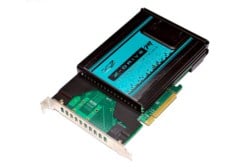OCZ Z-Drive m84 PCI-Express SSD Review
Under The Hood Of The Z-Drive





The Z-Drive m84 256GB PCI Express SSD we tested is what OCZ calls their "mainstream" product. It's based on a 4x64GB SSD RAID array and offers a bit less performance versus the p84 (Performance) or e84 (Enterprise) versions of the product. The Enterprise banded model is built with SLC NAND flash technology while the Performance and Mainstream products are made of MLC NAND flash. As you can see, disassembled, the Z-Drive is comprised of four primary components; the base RAID controller board and SSD shell housing, a backplane and power connector plate that provides data and power interfaces to the SSDs and the two SSD cards themselves. The on-board LSI RAID controller also talks to the SSDs over a single connector on the backplate as well.




The flash memory boards are rather interesting designs with a pair of SSDs on a single PCB with a single SATA interface, but each driven by their own Indilinx Barefoot SSD controller. Essentially, the design employs on-board RAID on a single PCB and across board RAID between the two SSD boards, hosted by the LSI RAID controller. Again, since the BIOS is locked down at the factory to a RAID 0 config, there is no significant utility within the LSI RAID BIOS itself, though we'd encourage OCZ to perhaps offer user configurable options (other RAID modes?) in future iterations of the product.
Regardless, as you can see, the solution is nicely packaged and again rather elegant, requiring a single 4-pin Molex power connector for the SSD array while the controller board derives its power from the PCIe slot. Speaking of power; let's power it up.
Regardless, as you can see, the solution is nicely packaged and again rather elegant, requiring a single 4-pin Molex power connector for the SSD array while the controller board derives its power from the PCIe slot. Speaking of power; let's power it up.






